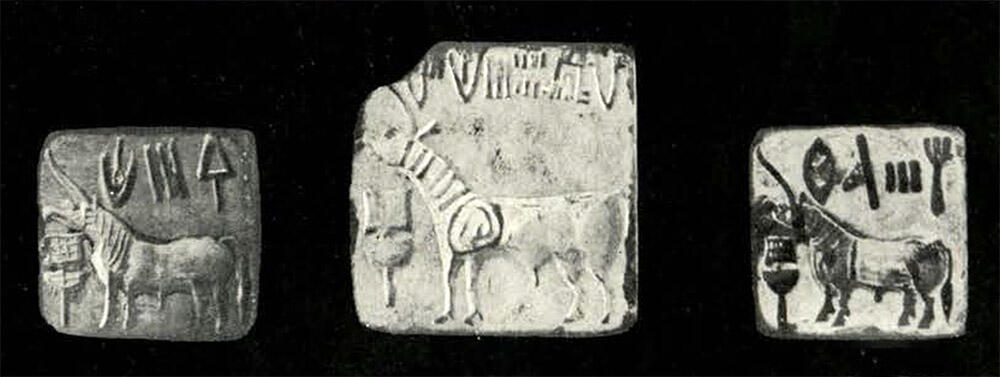"Among the antiquities found here was a seal die (No. A 214), Plate IX, Photos. Nos. 2817 a-b. It is square in shape, along each, side and provided with a round projection on the reverse pierced with a hole for the string by which it was suspended. It was found at the depth of 4 1/2 feet below the present ground level. The next fifty feet of the trench revealed no remains of any kind, though there were no signs of the area having been tampered with. . . . Among the minor antiquities found in this building special interest attaches to a seal matrix (No. A 263) (Photos. Nos. 2817 a-b), which is 1 1/2" square and has a hole in the reverse as is the case in No. A 214 mentioned above."
"As to minor portable antiquities, the greatest importance naturally belongs to the two seals in unknown script (Nos. A 214 and A 263). The legends and devices engraved on these seals are similar to those oh the three previously known to us from this site and now deposited in the British Museum, London. Mr. Y. R. Gupte, a former Assistant Surveyor in this office, obtained two seals and one sealing, and these are now in the Central Museum, Lahore. One of these latter is also illustrated along with the two dug up by me. A cursory examination of the characters on these three seals shows at least seven symbols which are not found on any of the seals deposited in the British Museum. Several scholars have dealt with the seals deposited in the London Museum, but evidently no satisfactory interpretation of the legends has as yet been obtained. The excavations being described have so far failed to supply any aid in the solution of the problem. Further particulars of these documents will be published in the special article-on these excavations."
- Daya Ram Sahni, Annual Progress Report of the Archaeological Survey [of India], Hindu and Buddhist Monuments, Northern Circle for the Year Ending 31st March 1921, p. 10, 11.
"These three seals are among the earliest unicorn seals discovered at Harappa. The placement of the script to the right of the horn and the left facing unicorn is most common during Period 3B at Harappa. See for more discussion Kenoyer J. M. & Meadow R. H. 2010. Inscribed objects from Harappa Excavations: 1986-2007, pages xliv-lviii. in A. Parpola, Pande B. M. & Koskikallio P. (eds.), Corpus of Indus Seals and Inscriptions, Vol. 3. New Material, untraced objects, and collections outside India and Pakistan, Annales Academiae Scientiarum Gennicae. Helsinki: Suomalainen Tiedeakatemia.
For more examples see also this intaglio seal with script and unicorn, a large unicorn seal, or this unicorn seal."
- Jonathan Mark Kenoyer, 2021.
A. 214 Seal matrix See p. 1.
A. 263 Seal die (1 1/2" square). The inscription which is in reversed countersunk characters consists of one line. Upper left corner is broken.
[Appendix D] 2817 Seals Nos. A 214 and A 263 found during my excavations and another seal with only three characters or symbols obtained by Mr. Y. R. Gupte.

